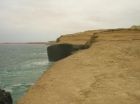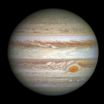(Press-News.org) VIDEO:
A new study uses carbon isotope dating to determine the first precise age for this bed, and ties the western coast of Africa to 30 million years of global geologic...
Click here for more information.
Paleontologists at Southern Methodist University have measured the carbon isotopes in marine fossils to precisely date for the first time 30 million years of sediments along Africa's South Atlantic shoreline.
The researchers matched the pattern of ratios of carbon-13 and carbon-12 isotopes in marine fossils from Africa's South Atlantic shoreline to known patterns of carbon ratios in fossils found elsewhere in the world. From that they determined the age of the coastal sediments at a fossil locality near the southern Angolan village of Bentiaba, said paleontologist Christopher Strganac, lead author on the study.
The analysis focused on a sequence of shoreline sediments totaling 140 meters thick. Their age spans a timeline of nearly 30 million years, from 95 million years ago to 68 million years ago. That period was about 40 million years after Africa and South America split, allowing the South Atlantic Ocean to slowly emerge.
The analysis revealed that the richest marine reptile fossil bed on Africa's South Atlantic dated to 71.5 million years ago, he said. This new date at the Bentiaba locality is more than 2 million years older than the estimated date of about 69 million years previously assigned to those marine beds by earlier researchers.
Africa's South Atlantic coast is remarkable in plate tectonics as the place where part of the prehistoric supercontinent Gondwana split 130 million years ago into what we now call Africa and South America.
"The precise age for these rocks allows better understanding of the ancient life and environments at Bentiaba by placing them accurately within the history of the ancient South Atlantic," said Strganac, a doctoral student in SMU's Roy M. Huffington Department of Earth Sciences. "It's a benchmark now from the Southern Hemisphere with which we can better understand ancient life at that time."
The precise dating was made possible by new scientific dating techniques. The age of the rocks hadn't previously been assessed because Africa's South Atlantic shore — noted for its puzzle-like fit with South America — has few localities with well-exposed rocks of this age. Also, it has been essentially unexplored by scientific expeditions since the 1960s largely because war and unrest prevented exploration in the previous century.
The new measurements stem from the work of Projecto PaleoAngola, an international team of scientists who in recent years have explored Angola and discovered an abundance of fossils. Their discoveries include the bones of dinosaurs, whales, mosasaurs and other ancient life from what is the richest marine reptile fossil bed along the South Atlantic coast.
Strganac and his co-authors report their findings in the Journal of African Earth Sciences. The article, "Carbon isotope stratigraphy, magnetostratigraphy, and 40Ar/39AR age of the Cretaceous South Atlantic coast, Namibe Basin, Angola," is available online through open access at http://bit.ly/1v4r8xi.
"This improvement in understanding the ages of the rocks along the shore is a great first step in trying to understand the climatic and evolutionary events that accompanied the growth of this ocean," said vertebrate paleontologist Louis L. Jacobs, also a co-author on the study and co-leader of Projecto PaleoAngola. Jacobs describes Angola as "an untapped frontier" for fossil hunters.
Aids in new knowledge of climate, temperature and vegetation
Scientists have recognized since the 1960s that ancient supercontinents split apart and their remnants drifted to the current positions of today's continents over the course of millions of years. One of the results was the creation of vast new oceans. Little is known of the vertebrate life that lived during that time along the eastern and western margins of the emerging South Atlantic Ocean.
Fossils being discovered now by Projecto PaleoAngola hold the key to understanding the South Atlantic Ocean's ancient past. Analysis of the fossils sheds light on the paleoenvironment, including changes in climate, temperature, vegetation and ecology.
The geologic time period covered by the 30-million-year sequence represents the Late Cretaceous. Studies have shown it was a period of dramatic change in climate, beginning with one of the warmest periods on Earth, then starting to transition to cooler climates, Strganac said.
Determining carbon ratios allowed comparison with global geologic events
To discover the age of the sediments, Strganac tested 55 fossil shells of ancient oysters and clams from 40 different rock layers on the coast. Testing determined the ratio of stable carbon isotopes, carbon-13 and carbon-12, in each shell. Because these isotopes do not decay with time, the relative abundance of each relates to the ocean when the shells formed. These isotope ratios can be compiled as a sequence with the rock layers, producing a pattern of carbon isotope change in the ancient oceans through millions of years. To accurately date the rocks, Strganac matched the pattern in isotope ratios in the shell record at Angola with the pattern known from ancient geologic events that occurred elsewhere in the world.
Specifically, the red rift-valley layers at Bentiaba were deposited as Africa and South America began to split. Also observed in the layers are a reversal in the Earth's magnetic polarity at 71.4 million to 71.64 million years to delimit the age of marine fossils; rocks deposited in the South Atlantic Ocean 93.9 million years ago during an oceanic anoxic event; and rocks south of Bentiaba that bracket the mass extinction of dinosaurs at 66 million years.
Besides comparing the stable carbon isotopes, other measuring techniques included: magnetostratigraphy, which measures the ancient polarity of the Earth's magnetic field when various sedimentary layers were deposited; and argon-argon radiometric dating of a volcanic basalt layer at the site, which measures the radioactive decay of potassium to argon and dates the cooling of the volcanic lava to 85 million years ago.
"Adding a new ocean to the globe, in this case the South Atlantic, has many long-lasting effects," said SMU's Jacobs. "One obvious example is the formation of energy resources found along the coasts of Brazil and Angola."
INFORMATION:
Strganac briefly describes the research on youtube at http://youtu.be/ii25ufRCLAk, with a scientific figure of matching carbon ratio patterns at http://bit.ly/1mvfisd.
SMUResearch.com on Twitter, http://twitter.com/smuresearch.
For more information, http://www.smuresearch.com.
SMU is a nationally ranked private university in Dallas founded 100 years ago. Today, SMU enrolls nearly 11,000 students who benefit from the academic opportunities and international reach of seven degree-granting schools. For more information see http://www.smu.edu.
SMU has an uplink facility located on campus for live TV, radio, or online interviews. To speak with an SMU expert or book an SMU guest in the studio, call SMU News & Communications at 214-768-7650.
Richest marine reptile fossil bed along Africa's South Atlantic coast is dated at 71.5 mya
A new study uses carbon isotope dating to determine the first precise age for this bed, and ties the western coast of Africa to 30 million years of global geologic records
2014-05-15
ELSE PRESS RELEASES FROM THIS DATE:
The shrinking of Jupiter's Great Red Spot
2014-05-15
Jupiter's trademark Great Red Spot — a swirling storm feature larger than Earth — is shrinking. This downsizing, which is changing the shape of the spot from an oval into a circle, has been known about since the 1930s, but now these striking new NASA/ESA Hubble Space Telescope images capture the spot at a smaller size than ever before.
Jupiter's Great Red Spot is a churning anticyclonic [1]. It shows up in images of the giant planet as a conspicuous deep red eye embedded in swirling layers of pale yellow, orange and white. Winds inside this Jovian storm rage at immense ...
KAIST made great improvements of nanogenerator power efficiency
2014-05-15
NANOGENERATORS are innovative self-powered energy harvesters that convert kinetic energy created from vibrational and mechanical sources into electrical power, removing the need of external circuits or batteries for electronic devices. This innovation is vital in realizing sustainable energy generation in isolated, inaccessible, or indoor environments and even in the human body.
Nanogenerators, a flexible and lightweight energy harvester on a plastic substrate, can scavenge energy from the extremely tiny movements of natural resources and human body such as wind, water ...
Low-dose anticoagulation therapy can be used safely with new design mechanical heart valve
2014-05-15
Beverly, MA, May 15, 2014 – Less aggressive anticoagulation therapy, combined with low-dose aspirin, can be used safely in conjunction with a newer generation mechanical heart valve. These findings from the first phase of a randomized clinical trial are published in The Journal of Thoracic and Cardiovascular Surgery, an official publication of the American Association for Thoracic Surgery.
Patients under 65 years of age requiring heart valve replacement have had to choose between a mechanical valve that may last a lifetime but requires aggressive anti-clotting treatment ...
Effects of alcohol in young binge drinkers predicts future alcoholism
2014-05-15
Heavy social drinkers who report greater stimulation and reward from alcohol are more likely to develop alcohol use disorder over time, report researchers from the University of Chicago, May 15 in the journal Biological Psychiatry. The findings run counter to existing hypotheses that innate tolerance to alcohol drives alcoholism.
In a double-blind, placebo-controlled study, a team led by Andrea King, PhD, professor of psychiatry and behavioral neuroscience at the University of Chicago, analyzed the subjective response of 104 young adult heavy social drinkers to alcohol ...
Visual clue to new Parkinson's Disease therapies
2014-05-15
A biologist and a psychologist at the University of York have joined forces with a drug discovery group at Lundbeck in Denmark to develop a potential route to new therapies for the treatment of Parkinson's Disease (PD).
Dr Chris Elliott, of the Department of Biology, and Dr Alex Wade, of the Department of Psychology, have devised a technique that could both provide an early warning of the disease and result in therapies to mitigate its symptoms.
In research reported in Human Molecular Genetics, they created a more sensitive test which detected neurological changes before ...
Sense of obligation leads to trusting strangers, study says
2014-05-15
WASHINGTON - Trusting a stranger may have more to do with feeling morally obligated to show respect for someone else's character than actually believing the person is trustworthy, according to new research published by the American Psychological Association.
"Trust is crucial not just for established relationships, it's also especially vital between strangers within social groups who have no responsibility toward each other outside of a single, transitory interaction. eBay or farmers' markets couldn't exist without trust among strangers," said lead author David Dunning, ...
Stability lost as supernovae explode
2014-05-15
Exploding supernovae are a phenomenon that is still not fully understood. The trouble is that the state of nuclear matter in stars cannot be reproduced on Earth. In a recent paper published in EPJ E, Yves Pomeau from the University of Arizona, USA, and his French colleagues from the CNRS provide a new model of supernovae represented as dynamical systems subject to a loss of stability, just before they explode. Because similar stability losses also occur in dynamical systems in nature, this model could be used to predict natural catastrophes before they happen. Previous ...
Marine scientists use JeDI to create world's first global jellyfish database
2014-05-15
An international study, led by the University of Southampton, has led to the creation of the world's first global database of jellyfish records to map jellyfish populations in the oceans.
Scientific and media debate regarding future trends, and subsequent ecological, biogeochemical and societal impacts, of jellyfish and jellyfish blooms in a changing ocean is hampered by a lack of information about jellyfish biomass and distribution from which to compare.
To address this knowledge gap, scientists used the Jellyfish Database Initiative, or JeDI, to map jellyfish biomass ...
Study: Addressing 'mischievous responders' would increase validity of adolescent research
2014-05-15
WASHINGTON, D.C., May 15, 2014 ─ "Mischievous responders" play the game of intentionally providing inaccurate answers on anonymous surveys, a widespread problem that can mislead research findings. However, new data analysis procedures may help minimize the impact of these "jokester youths," according to research published online today in Educational Researcher, a peer-reviewed journal of the American Educational Research Association (AERA).
VIDEO: Author Joseph P. Robinson-Cimpian discusses key findings: http://youtu.be/WFFaA74sygI.
"Inaccurate Estimation of ...
Neural pathway to parenthood
2014-05-15
Good news for Dads: Harvard researchers say the key to being a better parent is – literally – all in your head.
In a study in mice, Higgins Professor of Molecular and Cellular Biology and Howard Hughes Investigator Catherine Dulac have pinpointed galanin neurons in the brain's medial preoptic area (MPOA), that appear to regulate parental behavior. If similar neurons are at work in humans, it could offer clues to the treatment of conditions like post-partum depression. The study is described in a May 15 paper published in Nature.
"If you look across different animal ...
LAST 30 PRESS RELEASES:
Studies investigate how AI can aid clinicians in analyzing medical images
Researchers pitch strategies to identify potential fraudulent participants in online qualitative research
Sweeping study shows similar genetic factors underlie multiple psychiatric disorders
How extreme weather events affect agricultural trade between US states
Smallholder farms maintain strong pollinator diversity – even when far from forests
Price of a bot army revealed across hundreds of online platforms worldwide – from TikTok to Amazon
Warblers borrow color-related genes from evolutionary neighbors, study finds
Heat signaling from plants is an ancient pollinator signal
New index reveals the economics underlying the online manipulation economy
High-resolution satellite observations reveal facility-level methane emissions worldwide
Researchers discover how Ebola and Marburg disrupt the gastrointestinal tract
Feeling the heat
Eastward earthquake rupture progression along the Main Marmara Fault towards Istanbul
Scientists uncover how Earth’s mantle locked away vast water in early magma ocean
Scientists uncover key driver of treatment-resistant cancer
Rare image of Tatooine-like planet is closest to its twin stars yet
Music: Popular song lyrics have become more negative since 1973
Marine ecology: Killer whales tail dolphins to hunt salmon
ADHD prescriptions on the rise, study finds
How to build a genome
Sharp rise in ADHD stimulant prescriptions in Ontario, research finds
Trends and prevalence of the metabolic syndrome among US adults
Population-level trends in ADHD medication prescribing
Missing piece of myelin disturbs the brain’s rhythm
Insilico Medicine and Taigen achieves license agreement to develop and commercialize AI-driven PHD inhibitor for anemia of Chronic Kidney Disease (CKD)
Exploring dominant endophytic Pleosporales in grasses: New taxonomic insights in the suborder Massarineae
Comparative transcriptomic analysis of human maxillary and mandibular tooth germs reveals discrepancies in gene expression patterns
Scientists detect atmosphere on molten rocky exoplanet - study
Chip-scale magnetometer uses light for high-precision magnetic sensing
Illinois Tech biomedical engineering professor Philip R. Troyk elected as Fellow of the National Academy of Inventors
[Press-News.org] Richest marine reptile fossil bed along Africa's South Atlantic coast is dated at 71.5 myaA new study uses carbon isotope dating to determine the first precise age for this bed, and ties the western coast of Africa to 30 million years of global geologic records




